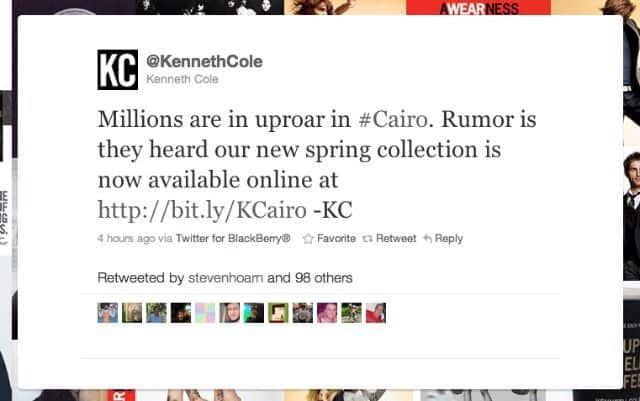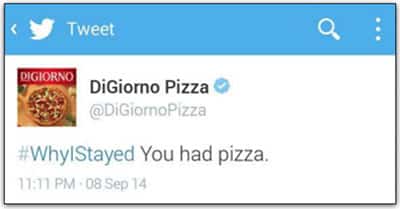5 Marketing Fails You Don’t Want to Make
by Rachel Pluck
Insights / Digital Marketing /

Successful marketing combines the strict elements of data and analysis with the fluidity of creative design and execution.
And although many of today’s great marketing campaigns are filled with intangible components that make them….well, great, there are several things you can do — or in this case, not do — to help you achieve success.
Avoid an epic failure in your next marketing campaign by staying away from these five marketing fails.
1. Marketing in a bubble
Some of the best marketing campaigns we’ve seen in recent years are able to latch onto something major happening in pop culture and use it to the advantage of the brand.
But what happens when your marketing campaign is completely insensitive to the culture and current events of your target audience?
You get the #1 marketing faux pas on our list: Marketing in a bubble.
Newsjacking is a terrible idea if it’s going to offend millions of people (Never heard of the term? Check out our blog post covering what newsjacking is and how to do it).
Consider this tweet from Kenneth Cole.
The tweet, which was supposed to be a nod to the political turmoil happening in Egypt in 2011, was met with uproar by the public and was taken down not long after it went live.
More recently, Pepsi came under fire in 2017 for a television ad starring Kendall Jenner that attempted to play on the Black Lives Matter movement. In short, Jenner leaves a photoshoot when she notices a protest going on down the street. As she approaches the front line of the protest, she hands an officer a Pepsi, everyone smiles and the world is at peace once again.
Many viewed this ad as a terrible appropriation of a significant racial protest movement to sell soda. Public outcry ensued and Pepsi pulled the ad and issued a public apology.
The point? Be aware of your audience and the significance of a trend or event before you try to use it in a marketing campaign. You could risk losing millions of dollars in ad spend and, most importantly, the loyalty of your customers.
2. Not doing enough research first
Whether you’re expanding into an unfamiliar international market or considering a product launch targeting a new demographic, you need to do your homework.
Back when Pepsi was first launching their product in China, they went with the tagline, “Pepsi brings you back to life.” Okay, it could probably use some work, but it’s not too terrible, right?
Wrong.
They forgot to do their homework and ended up launching an international campaign with what translated to, “Pepsi brings your ancestors back from the grave.”
Uh, what?
Needless to say, they should’ve spent a little extra time up front working with native speakers of the language to ensure a faux pas like this never happened.
3. Not giving your audience what they want
When you’re marketing something, especially a new product or service, it helps if you can be absolutely sure that it’s something your audience wants.
Does it solve a problem they have or provide something that will better their lives in some way?
If you answered no to the above, then you’re probably on the road to our third marketing faux pas.
You wouldn’t be alone.
In April 1985, Coca-Cola announced that it would be changing its classic formula (Hm, we’re seeing quite a trend here with soda brands, aren’t we?).
The reason? They wanted to compete with Pepsi, who was running a campaign claiming their soda was preferred by customers during blind taste tests.
The public was not happy with the change.
A consumer firestorm ensued and the brand quickly reverted back to the original formula within 79 days of launch, losing valuable time and profits.
Coca-Cola made a huge decision without consulting their audience and evaluating their needs and wants. And while the brand of course lived to fight another day, the decision could have been detrimental to a smaller business who could not withstand the losses.
4. Failing to select a target audience
One of the first things a brand should identify when launching a marketing campaign (or better yet, before launching the business in the first place) is its target customer base.
No matter how good your product or service is, it can’t possibly please everyone.
You need to drill down to the group of people that will benefit most from what you have to offer and go after them with your marketing strategies.
While it may seem counterintuitive to purposely exclude some people from your strategic plan, trying to reach an extremely wide audience is going to cost you in the long run.
Consider one of Ford Motor Company’s biggest blunders: the Edsel.
Completely ignoring any research and focus group material they had gathered, Ford presented 18 different design variations of the Edsel at launch in an attempt to please everyone.
The lack of focus on a specific market lead the company to release a car that wasn’t ready, which had oil leaks, sticking trunks and hoods and countless other problems.
Ford ended up losing about $350 million on the project, all because they failed to select their target audience and produce a product accordingly.
5. Jumping the gun
In today’s digital landscape, marketers are forced to move faster than ever to edge out competitors and gain the attention of their audience.
However, when you move too quickly on something without considering the consequences, you may end up making this marketing faux pas.
In 2014, DiGiornio Pizza jumped the gun when they jumped onto trending hashtag #WhyIStayed before learning its meaning.
If they had checked out the recent tweets, they would’ve seen the hashtag was about domestic violence and hopefully wouldn’t have used it.
While speed and agility are extremely important in the marketing world of today, vetting your information and strategizing a message still reign supreme.
It takes a lot to make a marketing campaign effective, but it takes just one of these mistakes to make it crash and burn.
So put your best foot forward and avoid making any of these major marketing faux pas. Your audience will thank you for it.
Did we miss anything? Share the worst marketing faux pas you’ve heard of with us on Twitter.






